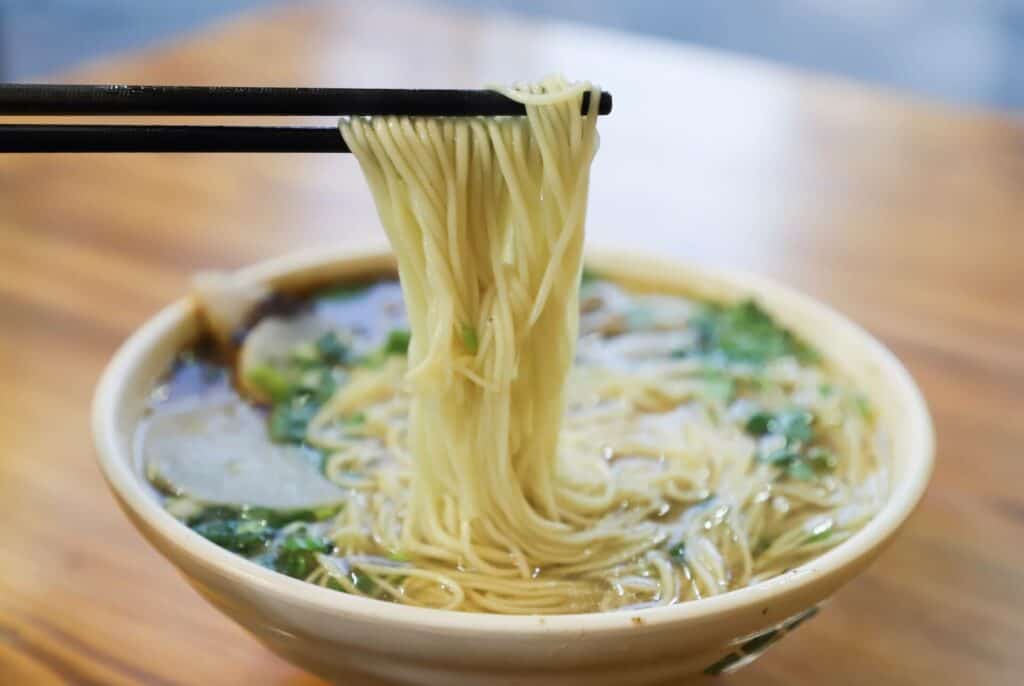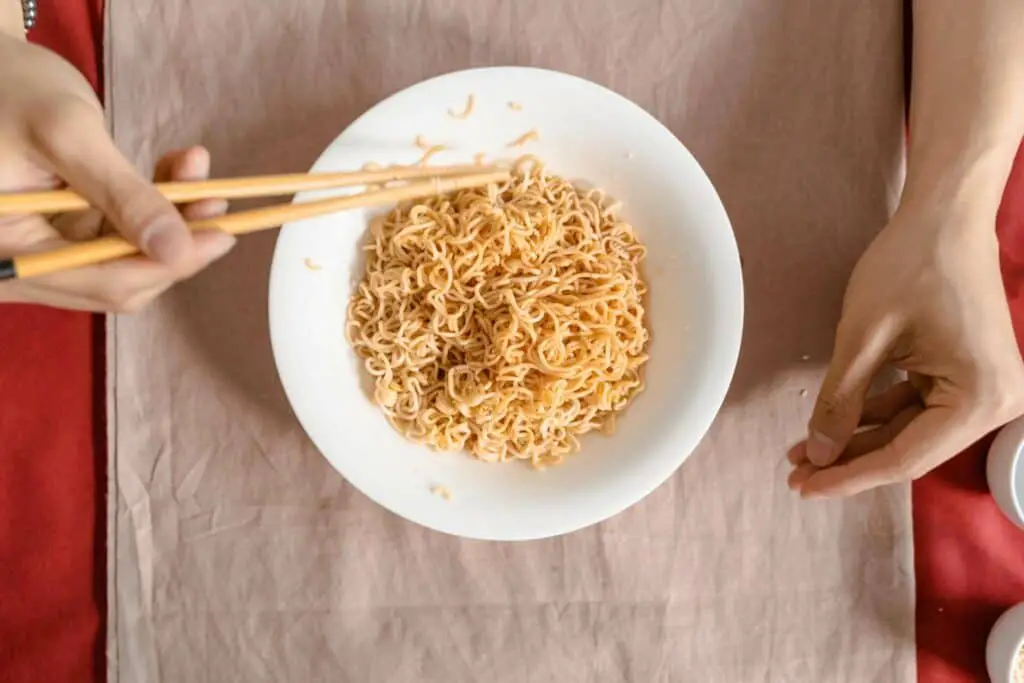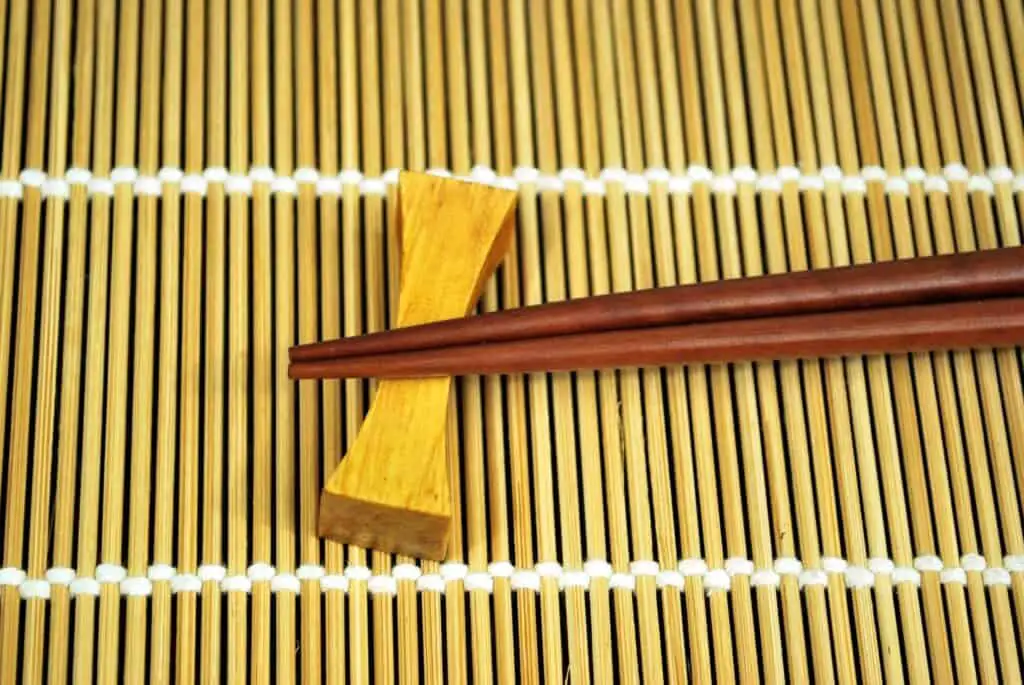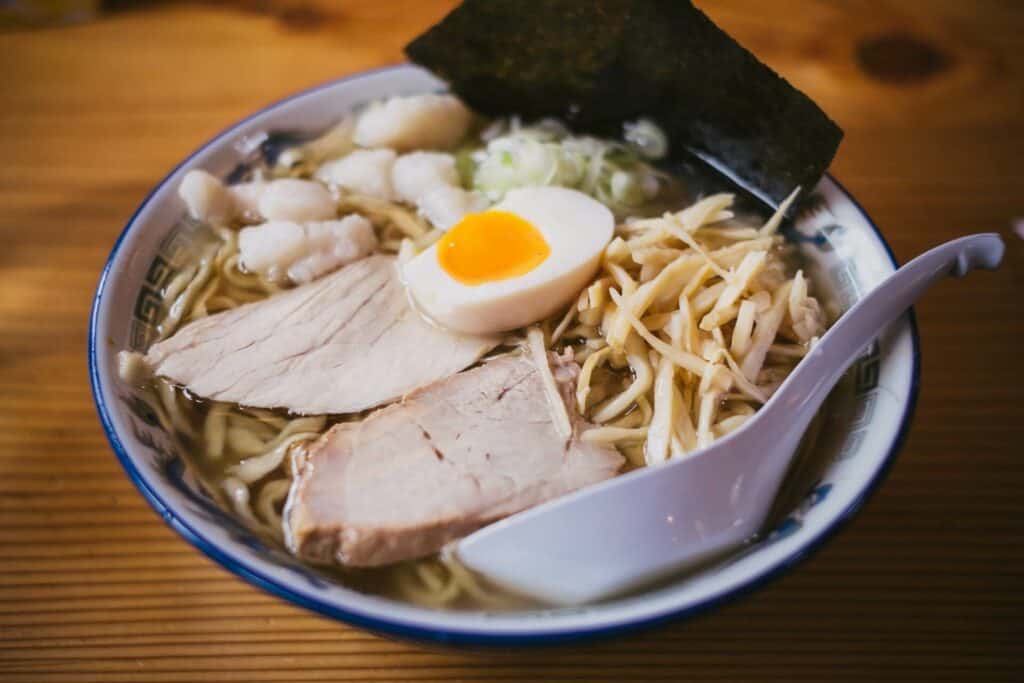It may seem impossible to learn how to use chopsticks for ramen, but with a bit of practice, you can quickly become a pro.
The recipe for perfectly holding each utensil lies in patience, perseverance, and coordination. Here are the steps you need to take:
- Hold the chopsticks with your dominant hand
- Rest one chopstick on the second knuckle of your ring finger and the crease between your thumb and index finger
- Set the second utensil on the first knuckle of your middle finger
- Hold the second chopstick with your index finger and thumb
- Keep the bottom utensil stationary while eating ramen
- Slurp the noodles and hold the ends with the chopsticks while slurping
- Use a spoon for the soup
What You’ll Need
- A set of chopsticks
- Spoon
- Bowl of ramen noodles
- Chopstick helper (if necessary)
Video Tutorial
The video below from WikiHow explains holding these utensils perfectly. It may take some practice, so watch the video more than once.

Step 1 – Hold the Chopsticks With Your Dominant Hand
If you wish to eat ramen like Naruto, using your dominant hand is the most important aspect of eating with chopsticks. Whether that’s your right or left, it will be more helpful in holding and learning how to utilize them.
When you learn for good, you can try holding the sticks with your non-dominant hand; you’ll notice how it seems impossible to coordinate and get the perfect grip. If it feels that way with the hand you often use, practicing that will make it perfect.
Don’t Worry if You Can’t Do It – You’ll Practice
It may seem impossible now, but don’t give up yet – you may not have to finish this bowl of Japanese noodles with traditional cutlery, but the next one is yours for the taking. In fact, every new meal is an opportunity to learn the way of using these dining tools.
Even if it’s a slice of fruit, try picking it up with your chopsticks to get more experience under your belt. That way, you’ll feel like a star when trying to impress the staff at a Japanese restaurant next time.

Step 2 – Rest One Chopstick on the Knuckle of Your Ring Finger and the Crease Between Your Thumb and Index Finger
The first thing to master is the placement of the bottom utensil. This one stays still while you eat; it shouldn’t move. Take one, and first, place it on the crease between your thumb and index finger.
Then, place your ring finger below the stick, landing it on top of your upper knuckle. This knuckle is closer to the nail, on the upper half of the finger. The stick should now be on your ring finger and between your thumb and index finger.
Step 2 – Set the Second Utensil on the First Knuckle of Your Middle Finger
Use your non-dominant hand to set the second stick onto the upper knuckle of your middle finger. Your index finger should naturally gravitate toward the stick, trying to keep it in place. If it doesn’t, that’s the next step.
The second utensil will be the one that moves and grabs the noodles when you start eating.
Step 3 – Hold the Second Chopstick With Your Index Finger and Thumb
After placing the second stick on your middle finger, lower the index finger to keep it firmly in place. It’s essential to try this more than once to feel the natural grip of your dominant hand.
Use the tip of your thumb to grip the upper utensil more firmly. You’ll notice how it is now movable, so try to connect the tips of both sticks several times before grabbing food.

Step 4 – Keep the Bottom Utensil Stationary When You Eat Ramen
The bottom utensil shouldn’t move while eating. If you drop it, that’s OK, but you’ll get a perfect grip on your food by keeping it still. Think of it as a base, while the upper utensil is like a food gatherer.
Metaphors may sound silly, but if there’s anything that will work in assisting you here, that’s great. When you grab the noodles, the upper utensil will go away further and then come back together with the lower utensil to tighten the grip on the noodle.
It’s like using your hand to grab something – your fingers must open and then close to hold the thing in question.
Try Holding Your Chopsticks With Helpers
People with shaky hands, arthritis, or Parkinson’s disease can use plastic helpers to get a good grip on their utensils. These helpers are also the best tools for people who can’t seem to fathom the concept of holding the sticks yet – you’re also valid.
You can purchase chopstick helpers on Amazon for a very reasonable price and use this equivalent to training wheels on a bicycle to eat some delicious noodle meals.

Step 5 – Slurp the Noodles and Hold the Ends With the Chopsticks While Slurping
When you make this at home (I recommend the Ichiran instant noodle kit), prepare to slurp them while eating. Of course, if it bothers the people in your household, you don’t have to, but slurping is highly recommended if you order this at a Japanese restaurant. You’ll see that it’ll be easier to get the noodle bunch into your mouth; just don’t forget a napkin.
Slurping Ramen Noodles Is Common in Japan
Ramen has noodles in soup, so they’re wet, slippery, and tough to grip with any utensil. That’s why Japanese people eat loudly, slurp every noodle bite, and even lift the bowl to drink the rest of the soup at the end.
Slurping is also a sign of delicious food; if you do this in front of the chef who made your meal, they’ll take it as a compliment. Slurping is synonymous with enjoyment in Japan, so you can eat as loudly as you like, as long as you don’t make a mess.
Step 6 – Use a Spoon for the Soup
When eating this Japanese dish, take a break from the struggle with chopsticks and dip a spoon into your soup. This is another utensil commonly used when eating ramen and other types of noodles with broth.
This will help you finish your meal and even hold the ends of your noodle bunch when you lift them.
You Can Also Slurp the Soup From the Bowl
Try not to make your noodle seasoning too spicy, or else the soup will be hot and impossible to eat. If this happens, you can also slurp the soup to make it cooler and dose the amount of spiciness you consume.

Final Thoughts
If you’re keen on learning how to eat this noodle dish with chopsticks, I suggest you find the best ramen on Amazon, grab a pot, and start cooking. Make the dish your liking, and follow these instructions for the best chopstick-holding results.